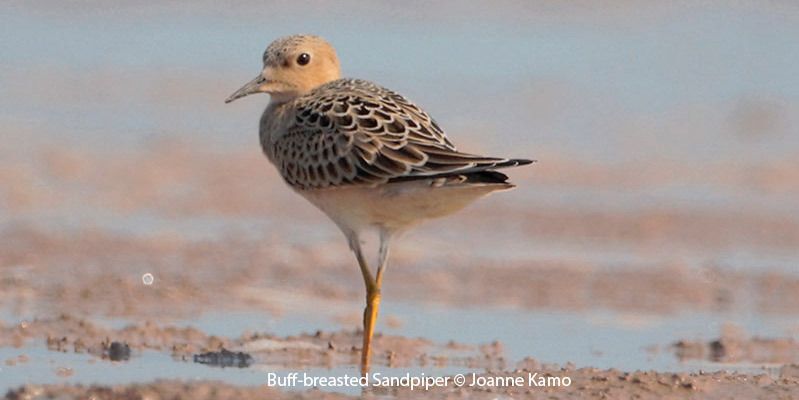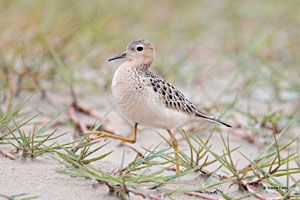
© Joanne Kamo
Buff-breasted Sandpiper
Calidris subruficollis
Family: (Scolopacidae) Sandpipers and Phalaropes
Preferred Habitat: Short grass prairies, plowed fields
Seasonal Occurrence: Uncommon in spring and fall.
Notes by Glenn Olsen: One of our most sought-after shorebirds, this beautiful sandpiper is most often found in that diminishing habitat that we call the shortgrass prairie. If we are fortunate, we find this sandpiper when it migrates through our area. Around here, the shortgrass prairie is gone, replaced with shortgrass pasture, parks, golf courses, and sod farms. In fact, sod farms and grassy parks are good places to search for this sandpiper. It may also be found searching for food in other open type habitats like recently tilled farmland, damp rice fields with emergent vegetation, and damp to dry fields with stubble from last year's crop.
Roughly the size of a cardinal, the characteristic coloring of this species is buff—not only the breast but also the back. Buff means a pale yellowish-brown (ochre) color. The back appears mottled because of the dark brown and black centers of the feathers. A rounded, dove-like head with a pale buffy face and a prominent black eye create a distinct facial image. The buff breast fades into a whitish lower belly and undertail coverts completing the color pattern.
It is thought that the species once numbered near a million or more birds. Loss of habitat and over-hunting before the establishment of the Migratory Bird Treaty Act dramatically impacted this species. Estimates now range from as low as 54,000 to a high of only 84,000 individual birds.
A long-distance migrant, the Buff-breasted Sandpiper spends the months of our winter in the grasslands of South America, primarily Argentina. In the spring, the birds travel north, some stopping in our area to rest and refuel. This half of their journey is approximately 5,000 miles. Once rested and nourished, they continue their journey (3,600 or more miles) to the breeding grounds of the arctic regions of northern Canada, Alaska, and Siberia. Here, males find a small spot to begin a display ritual to attract a mate. We call this area where a male bird performs courtship rituals or displays a lek. The Buff-breasted Sandpiper is the only known shorebird in North America that uses a lek!
Profile by Jon Piasecki: Buff-breasted Sandpipers have one of the longest migration journeys of any bird in North America. This species winters in the southeastern region of South America and breeds in the High Arctic around the northernmost parts of Alaska and Canada. Buff-breasted Sandpipers are predominantly central flyway migrants, so the Upper Texas Coast is one of the best areas to get a glimpse of these birds during migration. Typically, the most common place to see this species is out in open, low-cut fields. However, it is also possible to see Buff-breasted Sandpipers along the beach foraging on the shoreline.
Buff-breasted Sandpipers have a very beautiful coloration pattern including a black, scaly back, yellow legs, short black bill and an overall buffy-tan color in their breast and head. In flight, their underwings are a clean, bright white with a buffy colored wing bar near the wrist. Juveniles are very similar to adults but have a more defined and detailed scaly pattern on the back.
Unlike most shorebird species, Buff-breasted Sandpipers have a lek mating system. Upon reaching the breeding grounds in the High Arctic, male sandpipers will begin to display, and the chaos ensues. During a lek, several males will form a group and begin to display for any females that are around them. There have been at least 17 different display behaviors recorded in Buff-breasted Sandpipers but the most common involves the male raising its tail and slowly waving one of its wings to flash the bright white underside for the female. They may also leap into the air similar to a ballet dancer or figure skater. Once a male has the attention of a female, he opens his wings, puffs out his chest and stands on the tips of his feet while moving toward the female. Other males will often try to disrupt a displaying male either by being obnoxious or even by pretending to be a female sandpiper. Once a pair mates, the female will build a nest and raise the chicks without the help of the male. Females typically build nests in dry areas of the Arctic tundra and lay between 2-5 eggs.
Buff-breasted Sandpipers were once very abundant with populations estimated to be in at least the hundreds of thousands. As a result of hunting and mass conversion of prairies into agriculture fields, the population plummeted close to extinction. Today it is estimated that there are around 56,000 breeding adults but the species may once again be on the decline. We recently had a sighting of a Buff-breasted Sandpiper at Bolivar Flats Shorebird Sanctuary in April, 2023, so be sure to keep an eye out for these beautiful birds the next time you are on the beach or near open grasslands!
-
Cornell Lab of Ornithology
-
Field Guide
-
Bird Library
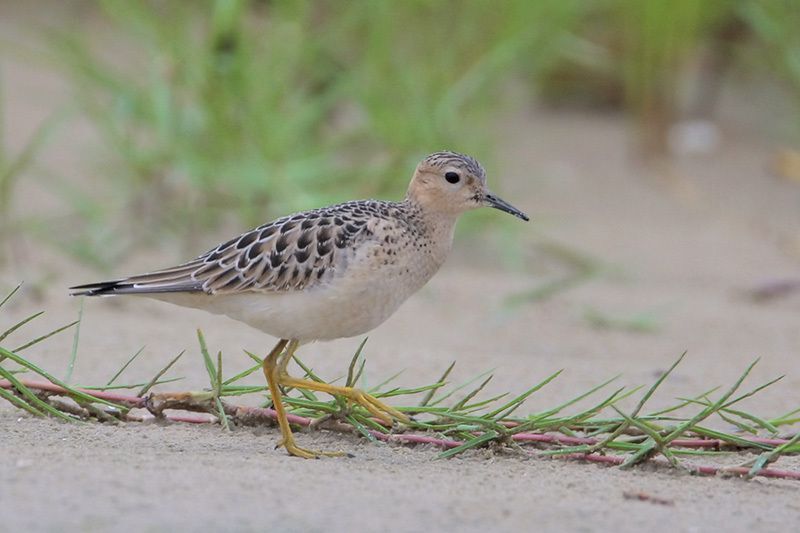
© Greg Lavaty, www.texastargetbirds.com
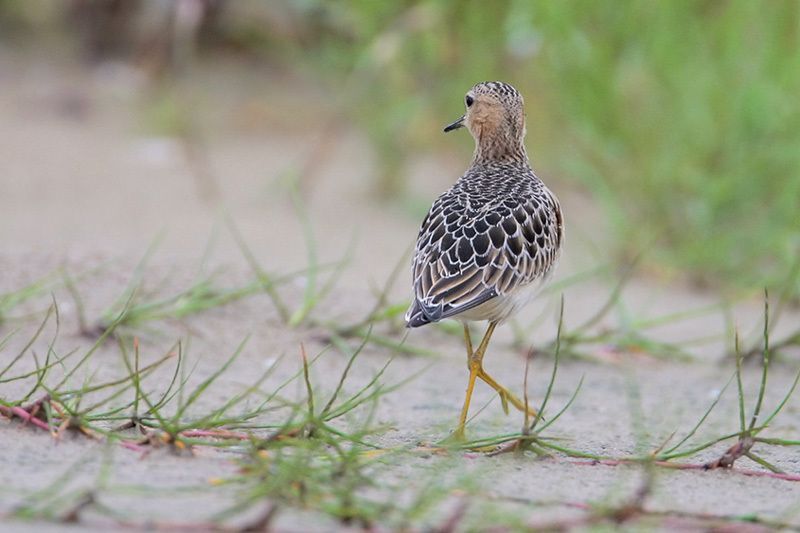
© Greg Lavaty, www.texastargetbirds.com
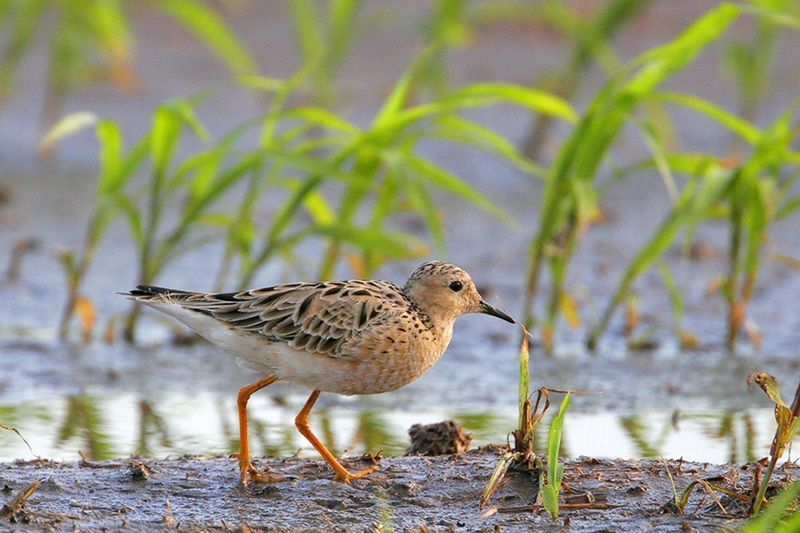
© Greg Lavaty, www.texastargetbirds.com
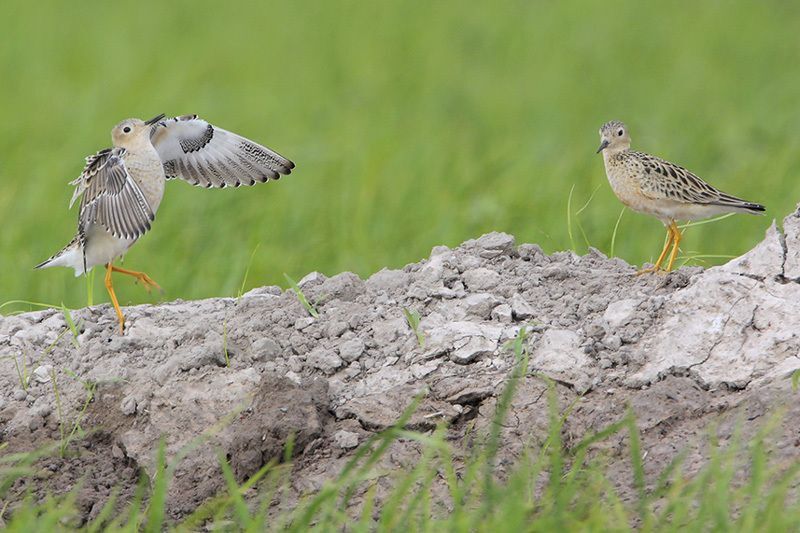
© Greg Lavaty, www.texastargetbirds.com

